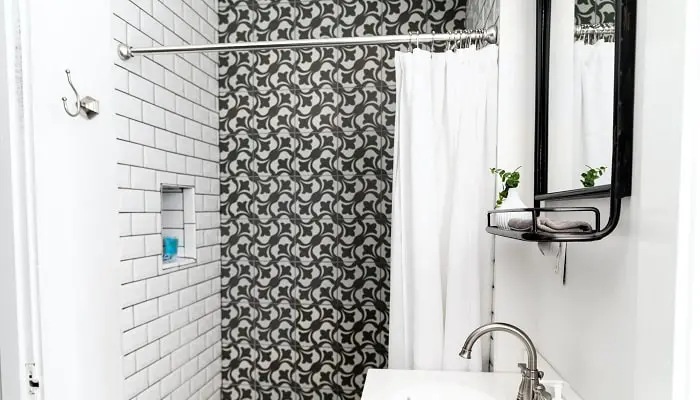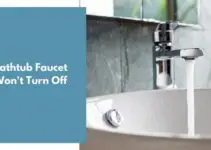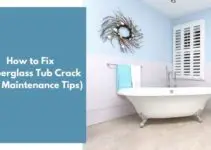FRP which is a short term for Fiber-reinforced plastic is a mixture of different materials like polymer and other fibers such as glass. FRP panels are used to fortify various structures. This makes it good for your shower walls. You might be wondering if FRP panels for shower walls would work out just right for you. If you are on the lookout for durability and classic style for your shower wall, here are some ideas for you. Read on and find out more.
Contents
- 1 Can FRP Be Used for Shower Walls?
- 2 What Is the FRP Panel?
- 3 Is the FRP Panel Waterproof?
- 4 How to Install FRP Panels in the Shower?
- 5 What Tools Do You Need to Install FRP Panels in the Shower?
- 6 How Difficult Is It to Install FRP Panels in the Shower?
- 7 What Is the Best Adhesive for FRP?
- 8 Does FRP Go Over Drywall in the Shower?
- 9 Summary
- 10 Resources
Can FRP Be Used for Shower Walls?
Yes, you can use FRP for your shower walls. Fiberglass is a type of Fiber-reinforced plastic that can be used in the bathroom. It is very typical to include fiberglass in shower wall projects since they are one of the least expensive materials to utilize.
FRP is a tough material but it is surprisingly light for its strength. It can surprisingly resist impact disproportionate to its volume which is enough for it to gain a reputation in the construction field. In comparison to traditional building materials like wood and steel, fiberglass lasts longer and is more durable.
FRP undergoes a process called pultrusion. This procedure to produce fiberglass is simply understood to be a continuous and repetitive action of pulling a material. Resulting from pultrusion is the multiple cross-sections that help it endure any force whether it is installed in a portrait or landscape position on your walls.
Fiberglass does not decay and it is not subject to corrosion therefore it does not have the disadvantage of rusting and this is still the case even if it is not shielded from moisture. This factor or feature of the FRP is especially suitable for shower walls since your shower can become really moist and wet.
Not only is FRP able to last long in different environments due to its high quality, but it can also add a vibrant atmosphere to your shower wall. FRP comes in different colors that you can choose from. Choosing the right one for your shower walls can totally make the difference.
What Is the FRP Panel?
FRP panels are known in many different names such as fiberglass reinforced plywood, fiberglass reinforced plastic, but mostly referred to as FRP by manufacturers and builders. FRP panels are strong despite their thin structure. These materials are flexible as well and have been used in different industries due to their tough engineering and modern appearance.
Is the FRP Panel Waterproof?
To answer simply, yes! The FRP panel has a kind of laminate system which means that it does not allow water to seep through its surface. It stands well for its name and because it is made of plastic material, water cannot easily penetrate past it.
Since the FRP Panel is water-resistant, you will not have trouble if you choose to install it in wet environments such as the bathroom. In fact, not only is it impermeable but it also makes the space where it is installed easier to clean.
How to Install FRP Panels in the Shower?
To install FRP panels you need to have the right size for the walls of your shower. It is also a good and practical idea to have a reinforcement of drywall in your shower wall before you install the FRP for protection from moisture. You can attach Fiber-reinforced plastic to the drywall straightaway.
Make sure that your walls are dry before you begin with the installation (supposing you will be doing it by yourself). Survey the surface where you will be installing the FRP and make sure that it is clear from any bulks and free from nails or other bumps since these small flaws in the walls’ surface will be visible because the FRP panels are flexible and it will not look good if they do show. When you are sure that your wall surface is flat, you may proceed to do the following steps.
- Measure the FRP panels to the size that would fit in your walls. Give ¼ inch allowance to the top and bottom parts of the FRP panels since they will still expand due to the moisture in the shower room. Doing so would prevent the FRP from ruining the installation.
- Apply adhesive to each FRP panel. Be certain to apply the adhesive as equally as possible. Firmly press the panel to the wall and then use a laminate roller to press the air out.
- After placing all the FRP panels, fix the divider rails vertically into place. Caulk the area around the FRP panels. Make sure that all are sealed into place and smoothed out to finish the installation.
If you want more visual guide, check the video below:
What Tools Do You Need to Install FRP Panels in the Shower?
There are several tools that you should obtain before you start installing FRP panels in the shower (the section earlier will have already given you a grasp of this). These tools are as follows: adhesive, silicone sealant, a fine-toothed saw (or a pair of shears could also do the trick), a trowel, and a laminate roller. These tools would come in handy when you begin the installation of the fiber-reinforced panels, but before proceeding to the actual process of placing the panels in the shower, you should also consider checking the environment where the installment is going to take place.
Make sure that the surface you will be putting the panels on is dry. FRP Standards for installation also suggests that the best temperature wherein to apply the FRP panels is at 70◦F. The materials should also be dry so there will be no problem afterward because everything has been polished before the actual application of the FRP.
How Difficult Is It to Install FRP Panels in the Shower?
The level of difficulty for installing FRP panels in the shower is average. It is not extremely hard and you can do it on your own. You just need the right tools for the task and an extensive amount of forbearance.
Starting a project with little knowledge will only get you a long way, so it is a good thing you have been reading this article through. You can definitely do the job successfully if you prepare the needed tools and give enough research to your undertaking of FRP panels installation. Looking over the location for your project is also an important step that will determine the degree of strain you will be having.
Installing FRP panels to your shower walls may be a simple project but it also needs a significant amount of waiting time. Usually for the panels to adjust to the moisture of the shower wall, it is recommended to be left there overnight. Then after the installation, it must be left for another 24 hours for the adhesive to totally dry.
What Is the Best Adhesive for FRP?
Fiber-reinforced Plastic has a non-permeable surface which makes just about any adhesive work fine on it, but the best adhesive to use is the construction adhesive. This type of adhesive is the most commonly used when attaching drywall, tiles, and other fixtures in the home. Construction adhesive performs well in the glass too and bonds a ton of other materials which makes it suitable for the job.
There are also other adhesives that could work well on fiberglass in case the construction adhesive is not available. Rubber-based adhesive like contact cement also bonds well in waterproof spaces like FRP panels. This can be a great alternative.
Does FRP Go Over Drywall in the Shower?
Yes, it does. FRP panels have been used in a wide variety of industries such as the following: aerospace, marine, automotive systems, construction industries and so many more. This being said, it is no surprise that the FRP panels could go over the drywall in your own home. With this information in mind about the FRP, it ultimately becomes a plausible choice to go over the drywall, making it tougher and more resilient.
Since the FRP is manufactured with polyester resin reinforced with fiberglass materials, it becomes tougher. Its attributes do not only go well when installed over the shower drywall (or any drywall for that matter) but it is also a good supporting structure for wood, concrete, rock, clay, etc. One more thing is that the FRP is scratch-resistant so it really helps maintain the comfortable look in any space inside the house.
Summary
To wrap things up, FRP panels have been a great help to many people all over the world and it is good to remember that these simple things do make houses feel more like home. Installation of FRPs has become easier over time as the right tools are made available in so many hardware stores. You don’t need to look so far anymore.
Furthermore, having the right skill set in order to do home projects is another story- you can actually get the job done all by yourself. FRP is not only durable and useful, but it is also cheap and you can always plan well for projects such as installing it in your shower. And if you do start this as your next home undertaking, this guide has got your back.
Resources
Image credits – Photo by Andrea Davis on Unsplash
FRP on Wikipedia




